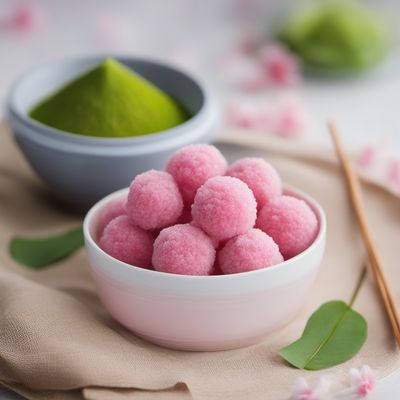
Recipe
Mangalorean Uirō Delight
Mangalorean Uirō: A Fusion of Japanese and Coastal Indian Flavors
4.7 out of 5
Indulge in the unique fusion of Japanese and Mangalorean Catholic cuisine with this delightful recipe for Mangalorean Uirō. This dish combines the traditional Japanese sweet treat with the vibrant flavors of Mangalore, resulting in a mouthwatering dessert that will transport your taste buds to the coastal region of India.
Metadata
Preparation time
15 minutes
Cooking time
25 minutes
Total time
40 minutes
Yields
4 servings
Preparation difficulty
Easy
Suitable for
Vegetarian, Gluten-free, Dairy-free, Nut-free, Vegan (if jaggery is substituted with a vegan sweetener)
Allergens
N/A
Not suitable for
Paleo, Keto, Low-carb, High-protein, Raw food
Ingredients
In this adaptation of Uirō, we incorporate the flavors and ingredients commonly found in Mangalorean Catholic cuisine. Instead of using traditional Japanese sweeteners like sugar or honey, we substitute jaggery, a natural sweetener widely used in Indian cooking. Additionally, we infuse the dish with the aromatic spices of Mangalore, such as cardamom and nutmeg, to create a unique flavor profile that reflects the coastal Indian region. We alse have the original recipe for Uirō, so you can check it out.
-
1 cup (200g) rice flour 1 cup (200g) rice flour
-
1 cup (240ml) coconut milk 1 cup (240ml) coconut milk
-
1 cup (200g) jaggery, grated 1 cup (200g) jaggery, grated
-
1/2 teaspoon cardamom powder 1/2 teaspoon cardamom powder
-
1/4 teaspoon nutmeg powder 1/4 teaspoon nutmeg powder
-
1/4 cup (20g) toasted coconut flakes, for garnish 1/4 cup (20g) toasted coconut flakes, for garnish
Nutrition
- Calories (kcal / KJ): 250 kcal / 1046 KJ
- Fat (total, saturated): 8g, 6g
- Carbohydrates (total, sugars): 42g, 25g
- Protein: 3g
- Fiber: 2g
- Salt: 0.1g
Preparation
-
1.In a large mixing bowl, combine the rice flour, coconut milk, grated jaggery, cardamom powder, and nutmeg powder. Mix well until the jaggery is completely dissolved.
-
2.Pour the mixture into a greased steaming dish or a silicone mold.
-
3.Steam the mixture for about 20-25 minutes, or until it becomes firm and translucent.
-
4.Remove the dish from the steamer and let it cool for a few minutes.
-
5.Once cooled, cut the Uirō into desired shapes, such as squares or rectangles.
-
6.Garnish with toasted coconut flakes.
-
7.Serve at room temperature and enjoy the delightful fusion of flavors.
Treat your ingredients with care...
- Rice flour — Make sure to use a fine rice flour for a smooth texture in the Uirō.
- Jaggery — If jaggery is not available, you can substitute it with brown sugar or palm sugar for a similar taste.
Tips & Tricks
- To enhance the flavor, you can add a teaspoon of rose water or orange blossom water to the mixture before steaming.
- For a richer taste, you can substitute half of the coconut milk with evaporated milk.
- Experiment with different shapes and sizes to make the Uirō more visually appealing.
Serving advice
Serve Mangalorean Uirō as a delightful dessert after a traditional Mangalorean Catholic meal. It pairs well with a cup of hot tea or coffee.
Presentation advice
Arrange the Uirō pieces on a platter and sprinkle some extra toasted coconut flakes on top for an attractive presentation. You can also garnish with a sprinkle of powdered sugar or a drizzle of chocolate sauce for added indulgence.
More recipes...
For Japanese cuisine » Browse all
For Mangalorean Catholic Cuisine » Browse all
More Japanese cuisine dishes » Browse all

Purin daifuku
Purin daifuku is a Japanese sweet made with mochi and a custard filling.

Narezushi
Fermented sushi
Narezushi is a traditional Japanese dish made by fermenting fish with salt and rice. It is a type of sushi that has been around for centuries and...

Karē pan
Karē pan is a popular Japanese snack that is made with a breaded and deep-fried shell filled with curry.









